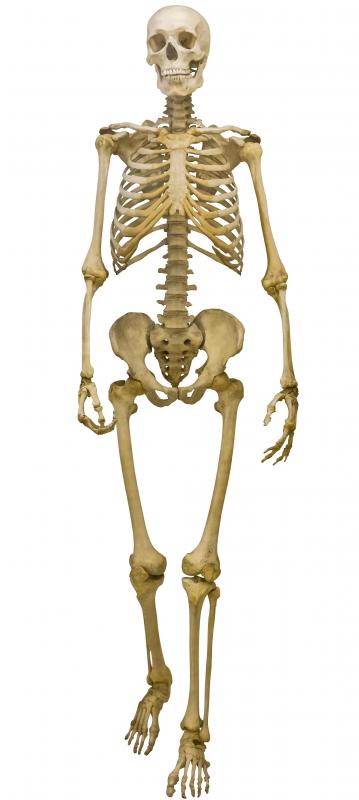At TheHealthBoard, we're committed to delivering accurate, trustworthy information. Our expert-authored content is rigorously fact-checked and sourced from credible authorities. Discover how we uphold the highest standards in providing you with reliable knowledge.
What is the Skeletal System?
Animal bodies are made up of many different systems that help them function on a daily basis. The skeletal system is one of these tissue combinations. It is made up of the body's bones, and forms the body's structure.
Body shape and form depend on the skeletal system. The human skeletal system consists of 206 bones that create a rigid foundation for the body. Allowing body movement is another skeletal function. Bones are also responsible for storing minerals, as well as protecting and supporting the body's organs.

In addition to storing certain minerals, such as phosphorus and calcium, some hollow bones also hold bone marrow. Bone marrow is responsible for producing blood cells. Every second, a human produces an average of 2.6 million red blood cells via his or her bone marrow.
Soft tissue and body organs are all attached to or contained within the skeletal system. The skull, for example, is nestled around the brain to protect it from harm, while the skeletal tissue around the heart and lungs forms the rib cage. Without these joints and bones encasing vital organs, they would be vulnerable to significant damage during even the lightest activity.

An animal's skeleton also interacts with the body's muscles to create movement. Muscles and bones are fastened together by tendons, which allow the body to stretch and move through a contraction. When a bone is connected to another bone through a ligament, it is called a joint. Sometimes, the muscular and skeletal systems are combined and called the musculo-skeletal system.
Human skeletons consist of two different sections. One section, called the axial skeleton, contains the bones that support the body's major organs of the neck, head, and trunk. These include the ribs, skull, vertebral column, and sternum.

Bones that make up the rest of the body are known collectively as the appendicular skeleton. They make up the arms, legs, shoulders, and pelvic region. These bones include the lower extremities, upper extremities, pelvic girdle, and shoulder girdle.
Four main types of bones exist, each for a different purpose. Long bones work as levers, and make up the lower and upper extremities. Flat bones, which are structured to protect organs as well as for optimal muscle attachment, include ribs and shoulder girdle bones. Wrists and ankles are made up of short bones, while irregular bones, such as those of the spine and skull, make up the rest of the body.
The bones themselves contain two types of tissue. Dense, hard bone is known as compact tissue, while spongy, porous bone is called cancellous tissue. Most bones are made up of both these tissues.
AS FEATURED ON:
AS FEATURED ON:













Discussion Comments
The skeletal system is controlled by the muscular system, which is controlled by the nervous system. When you send a signal to a muscle, the ultimate goal is the movement of the bone, for the movement of a body part in a given function. The brain orchestrates all these operations in a conscious and in an unconscious (involuntary) manner.
The skeletal system of kids is less advanced than that of adults. As time goes on, more bones develop, and bones lengthen and harden, stopping growth in adulthood. Bones are still replenished and strengthened on a regular basis, however.
Skeletal system diseases can cause great discomfort and make normal functions difficult. These include arthritis, which can be hereditary or come as a result of repeated injury. Cracking your knuckles may cause arthritis. Getting a healthy intake of calcium and other helpful nutrients and vitamins is vital to skeletal health.
Functions of the skeletal system include supporting all other systems with a basic frame, contributing marrow to cell growth, storage of this marrow, and protection of various other systems. The hardness of the skeleton can protect the brain and other vital organs from many things, and is a vital part of the anatomy of most animals.
Post your comments